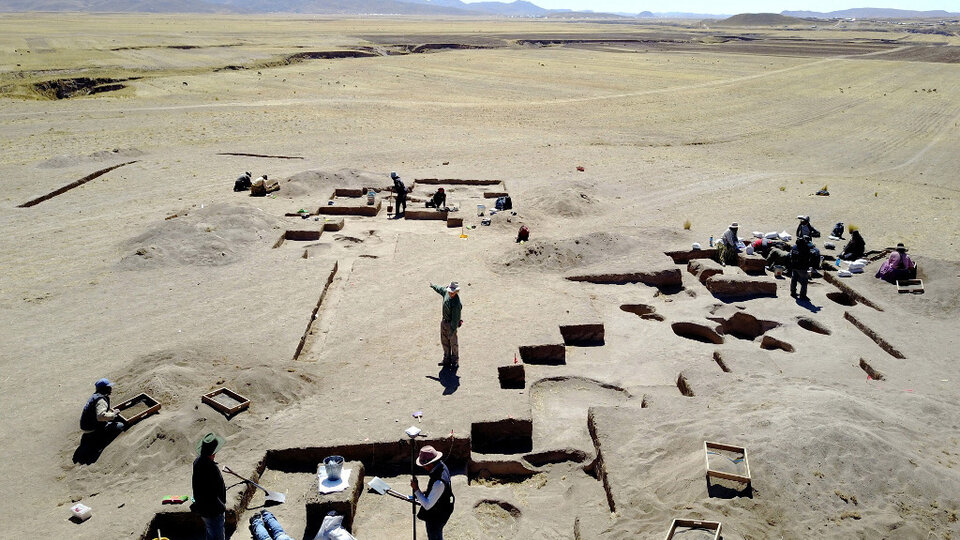
[ad_1]
A study into the discovery of the remains of a young woman, buried nearly 9,000 years ago in the Peruvian Andes with her weapons, found that the women of the time participated in the hunt, even big game. This conclusion It challenges the preconceived idea that this was not a task for men and raises new questions about the gender division of labor in the past.
The research results were published this week in the journal Sciences Advances and are based on the analysis of a team led by Randall Haas, a scientist at the University of California-Davis, who ensured that between 30 and 50% of hunters in the Americas at the time would have been women.
WMP6, the hunter
The study was based on the skeletons of six people, including two hunters, unearthed in 2018 by Haas, his team and members of the Mulla Fasiri community, in Wilamaya Patjxa, in the Peruvian district of Puno, an important archaeological site in the Andes Cordillera.
Bone and tooth analysis identified woman between 17 and 19, registered as WMP6, already a man between 25 and 30 years old. “The finds at this location were particularly interesting,” said Haas.
Scientists later discovered next to the woman’s remains sharp points, small spears, knife, carved stones and other objects used to dismember animals and empty their guts. Everything was in a bag that ended up falling apart, probably a leather backpack.
“This shows us that preconceived ideas were inaccurate, at least for part of human prehistory”, Randall Haas noted, referring to the belief that at the time women gathered and men hunted.
According to the specialist, the findings of this research also show that “today’s disparities in terms of wages, promotion and advancement in professional careers, between men and women, are not at all natural “.
“Work practices in recent hunter-gatherer societies are strongly gendered, which might lead some to believe that gender inequalities in areas like pay or rank are somehow ‘natural’. But it is now clear that the gender division of labor was fundamentally different, probably more equitable in the deep hunter-gatherer past of our species, ”he said.
According to the investigation, WMP6 would have used a weapon called an “atlatl”, a thruster that would have increased the speed and distance traveled by its spear. Their prey would have been mainly vicunas, wild ancestors of alpacas, and Andean fallow deer.
Something normal at the time
To find out if this woman was an exception, scientists studied about 429 skeletons buried in 107 locations across the Americas, dating between 17,000 and 4,000 years ago. There they found 27 people who were hunters and whose sex could be reliably established: eleven were women.
“The sample is sufficient to conclude that the participation of women in the tasks of hunting large prey was normal at the time”, specifies the team in its conclusions, which calculates, on the basis of all the data collected, that between 30 and 50% of the hunters in these companies were women.
In this sense, experts insist that this study adds a grain of sand to the theory that “often the modern idea of genres does not reflect the past”.
In 2017, a genetic study showed that the remains of a Viking warrior were actually those of a Viking. However, it is still unclear why other more modern hunter-gatherer societies have discriminated between the sexes in hunting activities.
The Haas team suggests that the reasons could be found in external influences, as the WMP6 thruster was perhaps easier to use than other weapons used later and boys and girls could learn to handle it before women do not reach the top. age of consecration to procreation. On the other hand, weapons like archery, for example, require long learning and constant practice.
Experts now want to understand how the gender division of labor and its consequences at different times and places have changed among the hunter-gatherer populations of the Americas.
In turn, they hope that this study will stimulate further research to find out whether other hunters existed at that time in other parts of the world.
.
[ad_2]
Source link
 Naaju Breaking News, Live Updates, Latest Headlines, Viral News, Top Stories, Trending Topics, Videos
Naaju Breaking News, Live Updates, Latest Headlines, Viral News, Top Stories, Trending Topics, Videos